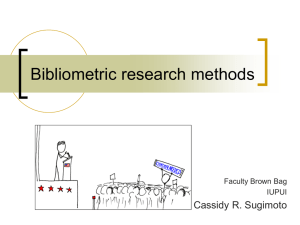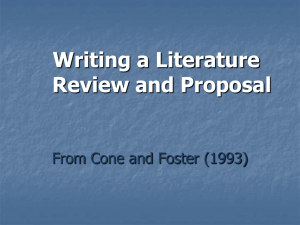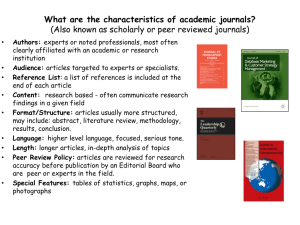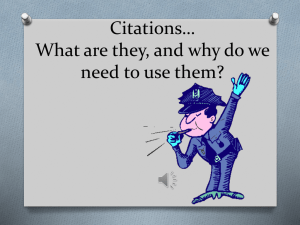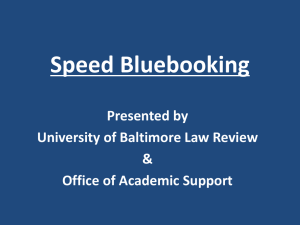Understand scholarly literature and find quality research articles
advertisement
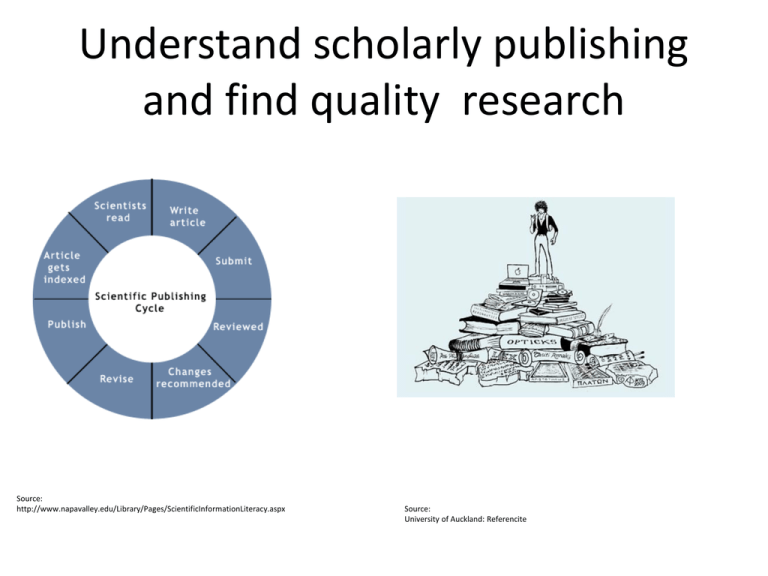
Understand scholarly publishing and find quality research Source: http://www.napavalley.edu/Library/Pages/ScientificInformationLiteracy.aspx Source: University of Auckland: Referencite “Publish or perish” Is the pressure on researchers to publish constantly to succeed in or sustain their careers. The success of academics and researchers is judged by how many times their research is cited by others and the quality of the journals they publish in Source: http://1.bp.blogspot.com/_Vr8Xl0cbUZA/SaEJ1atQ5VI/AAAAAAAAGNw/D- y6GKiAuA/s400/Image+%3D+Cartoon+Publish+Or+Perish+2.gif Source:http://th.physik.uni-frankfurt.de/~jr/gif/cartoon/cart0395.jpg Where to find academic literature for your research? Primary literature (research papers) The results of research is published in academic journals and to be published has to pass a rigorous review process by other researchers and experts in the field. This is called peer review. Secondary Literature In addition to research articles, sources like textbooks, and other reference-type materials can be valuable in providing background information, identifying key ideas and defining terminology. These types of sources are considered the “secondary literature” because rather than presenting new research, they provide a compilation or evaluation of previously published research. Academic or Peer Reviewed and Popular Journal Articles Many article databases include both peer reviewed journal articles and news articles from the popular business press. In business research, often both academic articles (for research on a topic ) and business magazines and newspapers ( for practitioner information) are useful and it is important to be able to distinguish between the two types when you are looking for good sources of information. Popular/News Articles •Are written by journalists or writers who may not have expertise in the topic •Rarely have an abstract or a reference list •Do not follow a formal structure • Audience is the public or practitioners While popular magazines provide an excellent source of current information and background on business issues to include in reports, they are not considered suitable sources for research required in academic writing. There are also many other specialised databases for business data and statistics to include in research Passport GMID provides information and data on consumer lifestyles, consumer market sizes, companies and brands, major market profiles, country data and market analysis. Business data & statistics at your fingertips What are the characteristics of academic journals? (Also known as scholarly or peer reviewed journals) • Authors: academics or researchers, usually affiliated with an academic or research institution • Reference List: a list of references is included at the end of each article • Content: research based - often communicate research findings in a given field • Format/Structure: often structured to include abstract, literature review, methodology, results, conclusion • Peer Review: articles are reviewed before publication by an Editorial Board who are peers or experts in their field. • Locate academic articles by using the specialized library subscription databases ? How do I tell if my article is a good one? (Has it had an impact on the research in its field? If a research article shows high citation metrics , it is likely that it has had an impact in its field. How do you find citation metrics? Citation counts can be found in : • Google Scholar - Lists citation counts and analysis of authors outputs. • Some business databases give citation counts– e.g.: Business Source Premier, ABI/Inform and Science Direct • Science Direct & Emerald list top papers. • Specialised research databases for citation analysis – Scopus & Web of Science Academic Journal rankings • Academic journal ranking lists can be found on the Web & in Journal Citation Reports database But- Citations counts don’t always work! Why? • New research won’t have a lot of citations as it hasn’t had time . • Not all referencing styles require, (like APA), that only material actually cited in the text can be in the reference list. • Environment – a researcher could be working in a small field, publishing in another language, publishing mainly in books. • Academic journals are of various tier levels, some are more prestigious than others. • Caution - Google Scholar doesn’t explain what it considers academic and what academic material is accessed • Some databases “cited by” feature is only for what is in their particular database • But they are very useful for enabling citation chaining … “I’ve only found one good article so far” That’s not so bad! With one useful article, you can use “citation chaining”. Citation chaining is where you use one good research article as a starting point to find more useful resources of similar quality Source: University of Sydney, iResearch: Information Skills for Life http://www.library.usyd.edu.au/elearning/learn/citationchaining/index.php The databases have tools to help you citation chain Business Source Premier and some databases link to “Times cited in this database” and have hyperlinked reference lists, see “Cited References” • Backwards chaining (cited references) is the process of looking at the reference list of a good article and identifying further good sources to locate and read • Forwards chaining (times cited) is linking to resources that have cited your starting article The reference list can also give clues as to the academic rigour and quality of a research article. When you click on “cited references” to see the references for an article. • • • Do references show that a comprehensive body of literature has been explored on the topic ? Do the references cited in your article have a high cite factor? Does the reference list combine both seminal (classic) and contemporary articles ? Times Cited in this Database: (1680) Citation databases To forwards chain, (see who has cited your article) specialised citation databases such as Web of Science, Science Direct and Scopus will do the chaining process for you Science Direct/Scopus database ScienceDirect links to “Cited by in Scopus”. Scopus is a comprehensive citation database that can be searched on its own or linked to from Science Direct (same company) Web of Science database You can use Web of Science database to find who has cited a particular article or book. Comprehensive coverage for tracking journal article citations, but not all business journals covered. Forwards chaining is a way of looking forwards in time, to research that has used your research article to develop and inform new research Times Cited: 130 (from Web of Science) Cited by in Scopus (29) Forward chaining can be a way to trace the on going development of an idea and find the very latest research on a topic Web of Science database has a citation map feature which gives you a visual map of citations At the article level, link to Citation Map In Web of Science you can see a visual map of both backwards and forwards citations by using the “Citation Map” link and see the impact a research article has had in its field What if I can’t find other articles that have cited my chosen article in the citation databases ? Not all articles will be included in databases with chaining functions and very recent research, despite being excellent quality will not have a cite history . Google Scholar also enables forwards chaining. Although the cite feature is not as accurate as in the citation databases, it can be helpful to check the article in Google Scholar to see if there is any forward citation chain Ranking the academic journals. As an example Management journals in the Journal Citation Reports database can be ranked by impact factor. Impact factor – The number of times articles from a journal are cited within 2 years divided by the total number of articles published in the same journal during the 2 year period Tips for Finding high quality academic articles • • • • • Search specialist business databases and limit database searches to “peer reviewed” or “scholarly” journals Use features of the databases to view & evaluate cited references & cited by listings Use citation chaining to track backwards and forwards research Use Google Scholar “cited by” features and author search. Use Scopus & Web of Knowledge citation databases & Journal Citation Reports database to see an articles impact & journal ranking. Critically evaluate the article: •Who is the target audience? When was the article published? •Does the title accurately reflect the contents? •Is the abstract to the article accurate, coherent, nonevaluative, succinct? •Is there a good introduction which orientates the reader to the content? •What are the authors credentials and affiliations? Are he/she/they an authority in the area? •Does the research design clearly explain the methodology and research approach? •Can you use the keywords to extend a search of the topic further? •Is the literature review broad, focussed and balanced? •Does the conclusion successfully present main points of the research, has it demonstrated that the research has presented fresh insights or perspectives? •Does the reference list demonstrate a comprehensive body of literature was explored? (Adapted from : Stockhausen L & Conrick,M. (2002) Making sense of research: A guide for critiquing a paper. Contemporary Nurse, 14, 38-48) Assessing the impact factor of research – Try it ! Use the article listed below, (or one you have) to investigate the impact the article has had on the literature of its topic Khoo, H.S. & Burch, G.S.J. (2008) The “dark side” of leadership personality and transformational leadership: An exploratory study. Personality and Individual Differences, 44 (1), 86-97 •Enter the name and a few words of the title in Google Scholar to see if you can locate the article. Use the “cited by” feature to forward chain to get an indication of the article’s research impact. •Enter the journal title in the e-journals link on the Library homepage to see which database has the files. Link to the chronological listing of volumes and navigate to the issue you need (volume 44, issue 1). Look for citation tools and link to the reference list to see the sources the authors have used to get an idea of the citation metrics and the quality of the research that has informed the article. Some databases give citation metrics for reference list articles as well as the original article. If you can, forward chain to see who has used the research , (for forward chaining see link to “Cited in Scopus”) •Link to the authors name in Scopus to see their academic affiliations and research standing •Use the Web of Science database to track the citation impact of the article. Combine an author name and title to locate the article. Click on the article to locate the citation map feature to visually map the research impact both forwards and backwards. •Use the Journal Citation Reports database to check the ranking of the journal the article was published in. Select JR Social Sciences Edition. To locate the journal, either use “search for a specific journal” and enter name or use view a group of journals by subject category and select the category “ Psychology, social”. You can use the drop down box to select to sort by “total cites” or “impact factor”
